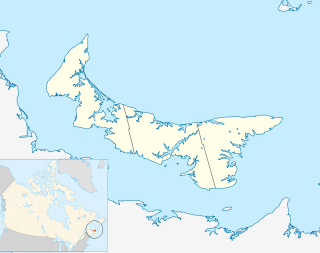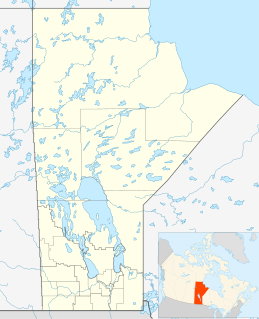
Canadian Forces Base Summerside was an air force base located in St. Eleanors, Prince Edward Island, Canada, now part of the city of Summerside.

Canadian Forces Base Greenwood, or CFB Greenwood, is a Canadian Forces Base located 1.5 nautical miles east of Greenwood, Nova Scotia. It is primarily operated as an air force base by the Royal Canadian Air Force and is one of two bases in the country using the CP-140 Aurora and CP-140A Arcturus anti-submarine/maritime patrol and surveillance aircraft. Its primary RCAF lodger unit is 14 Wing, commonly referred to as 14 Wing Greenwood.

RCAF Station Aylmer was a Royal Canadian Air Force airfield that was built between late 1940 and June 1941 northeast of Aylmer, Ontario. It was one of many built across Canada under the British Commonwealth Air Training Plan during World War II.

RCAF Station Vulcan, also referred to as RCAF Aerodrome Vulcan, was a Second World War flying training station located southwest of the town of Vulcan, Alberta, Canada. It was one of many stations that were established in Canada under the British Commonwealth Air Training Plan.

RCAF Station Kingston was a World War II air training station built in 1940 at Collins Bay near Kingston, Ontario, Canada. The station was originally built by the Royal Canadian Air Force (RCAF) for use by the Royal Air Force (RAF). Like other RAF schools in Canada, it was subject to RCAF administrative and operational control.

RCAF Station Pearce, or RCAF Aerodrome Pearce or BCATP Station Pearce, was a Second World War training air station of the British Commonwealth Air Training Plan (BCATP). It was located northeast of Fort Macleod, Alberta, Canada.
RCAF Station Fort Macleod was a World War II British Commonwealth Air Training Plan (BCATP) flying training station. Administrative and operational control was the responsibility of the Royal Canadian Air Force (RCAF). The old station is located south of Fort Macleod, Alberta, Canada.

Swift Current Airport is located 4 nautical miles east of Swift Current, Saskatchewan, Canada.

Canadian Forces Base Moose Jaw, also known as 15 Wing Moose Jaw, is a Canadian Forces base located 4 nautical miles south of Moose Jaw, Saskatchewan. It is operated as an air force base by the Royal Canadian Air Force (RCAF) and is home to RCAF Pilot training and 431 Squadron, the Snowbirds, which is the RCAF's air demonstration squadron.

Several air force stations and other establishments, many of them training facilities, operated in Calgary, Alberta, Canada from the mid-1930s to the mid-1960s.

Canadian Forces Base St. Hubert was a Canadian Forces Base in the city of Saint-Hubert, Quebec. The base began as a civilian airfield in the 1920s and was later also used by RCAF auxiliary (reserve) squadrons, beginning in the mid-1930s. It became a fully-fledged RCAF station early in World War II, being extensively used for training as part of the British Commonwealth Air Training Plan. After the war, it grew into one of the most important air bases in Canada, and remained so for decades.

RCAF Detachment Gananoque was a relief landing field for the Royal Air Force's No. 31 Service Flying Training School (SFTS) located at RCAF Station Kingston during the Second World War. The airfield was located north of Gananoque, Ontario, Canada. Gananoque consisted of a triangle-shaped runway pattern, one hangar, and a control tower. Gananoque officially became a British Commonwealth Air Training Plan (BCATP) facility in 1942 when RAF training schools became part of the BCATP. The station opened in 1940 and closed in 1945.

RCAF Station Assiniboia was a Second World War British Commonwealth Air Training Plan (BCATP) flying training station located near Assiniboia, Saskatchewan, Canada. It was operated and administered by the Royal Canadian Air Force (RCAF).

RCAF Station Gimli was an air station of the Royal Canadian Air Force (RCAF) located near Gimli, Manitoba, Canada.

RCAF Station Brandon was a Second World War British Commonwealth Air Training Plan (BCATP) station located near Brandon, Manitoba, Canada. It was operated and administered by the Royal Canadian Air Force (RCAF).

RCAF Station Estevan was a World War II, British Commonwealth Air Training Plan (BCATP) base operated by the Royal Canadian Air Force (RCAF). It was located South of the City of Estevan, Saskatchewan, Canada.

RCAF Station Davidson was a Second World War air training station located near Davidson, Saskatchewan, Canada.

RCAF Station Caron was a Second World War British Commonwealth Air Training Plan (BCATP) station located near Caron, Saskatchewan, Canada. It was operated and administered by the Royal Canadian Air Force (RCAF).

RCAF Station Yorkton was a Second World War air training station located near Yorkton, Saskatchewan, Canada.











